The country of choice
- Grants company should enter the Thai market because it has the most suitable environment compared to politically hostile Vietnam and religious Malaysia.
- Thailand has been under an indirect effect of globalization due to its tourism industry.
- The last decades of global market activity have been marked by increased competition in all sectors.
- The markets were seriously protected, and the positions of the dominant participants are clearly consolidated.
- However, it turned out that the development of a company is impossible without competition, but is forced to learn the art of race as a guarantee of future success and development of the company in the market.
- In this case study, we will consider new market integration, some tools, and techniques of corporate strategy functioning, the task of which is to stimulate the development of the company in the most effective way for it, and to use the position in the market for its purposes.
- The main goal of developing a competitive strategy is to adapt to constant changes in the competitive environment successfully.
- There are various managerial approaches to overcome intense market competition and rivalry, however, Grants might not suffer from it.
- In addition, Grants should enter Thailand market, because there is an increased interest in organic products (Sapbamrer, 2018).
- Competition in virtually any industry is managed by several processes. These include the bargaining power of suppliers, the bargaining power of customers, the threat of the emergence of identical products or services, and the risk of new entrants entering the market.
- New players in the market bring with them new production facilities, technologies, materials that may pose a real threat to our business.
- Many participants come from other markets where they have already achieved success and use previously proven promotion methods (Wuthisatian, 2014). Thus, they can very quickly bring down both the market and our positions on it.
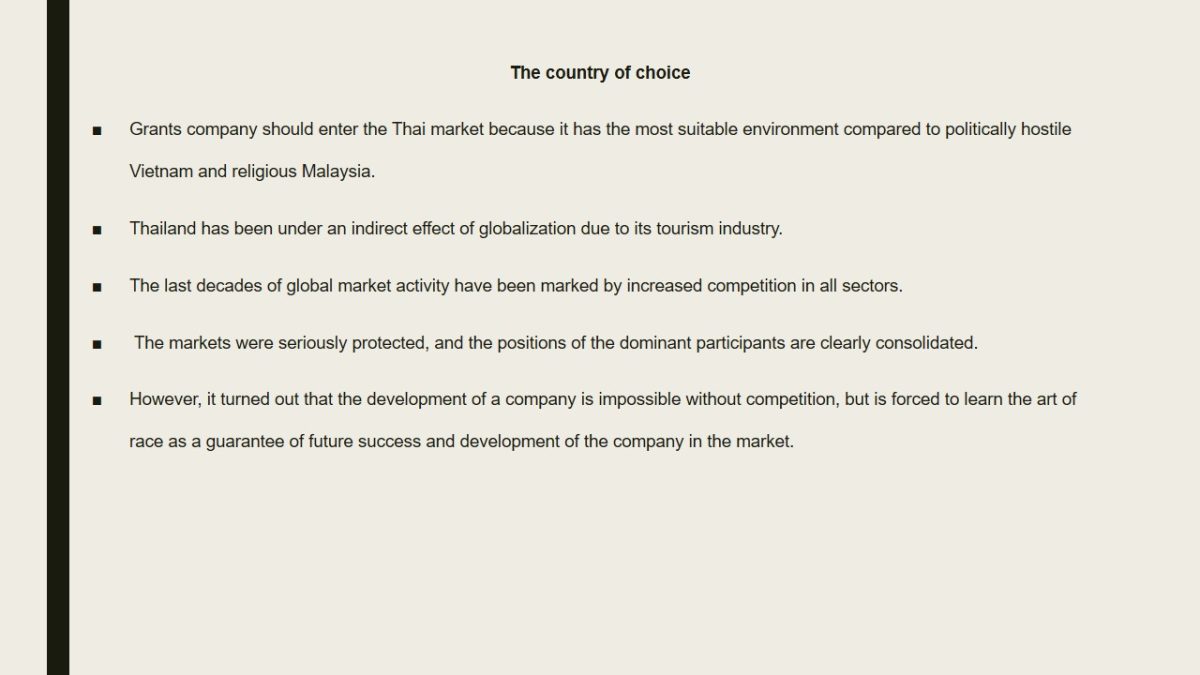
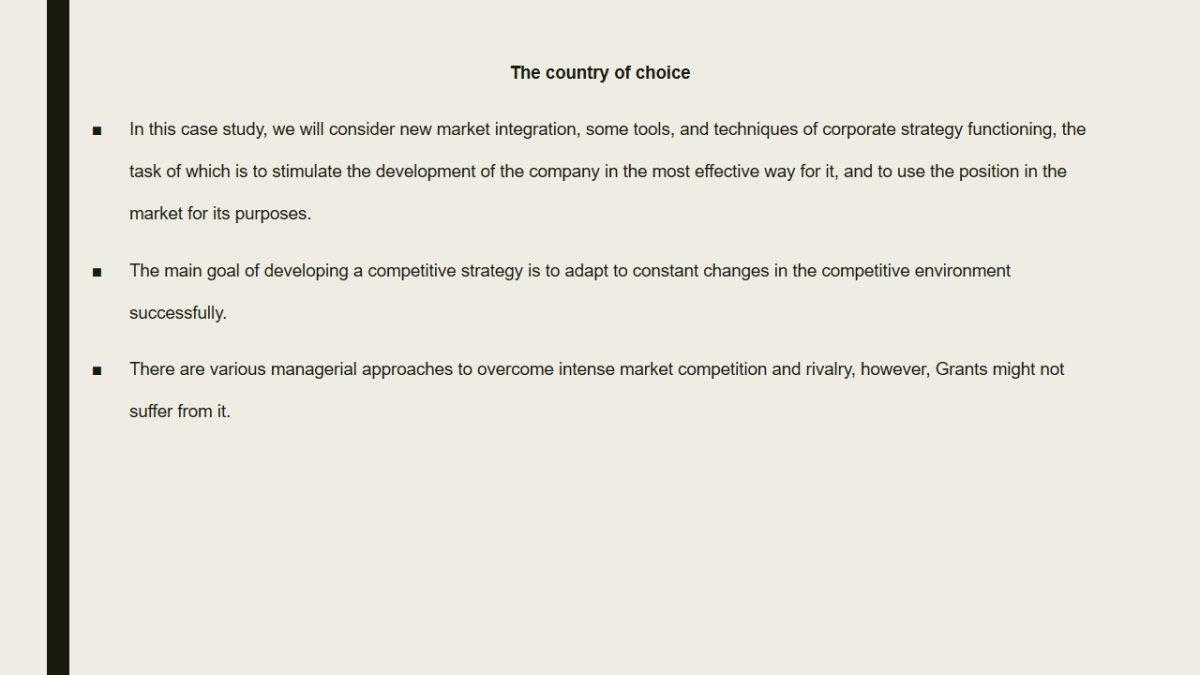
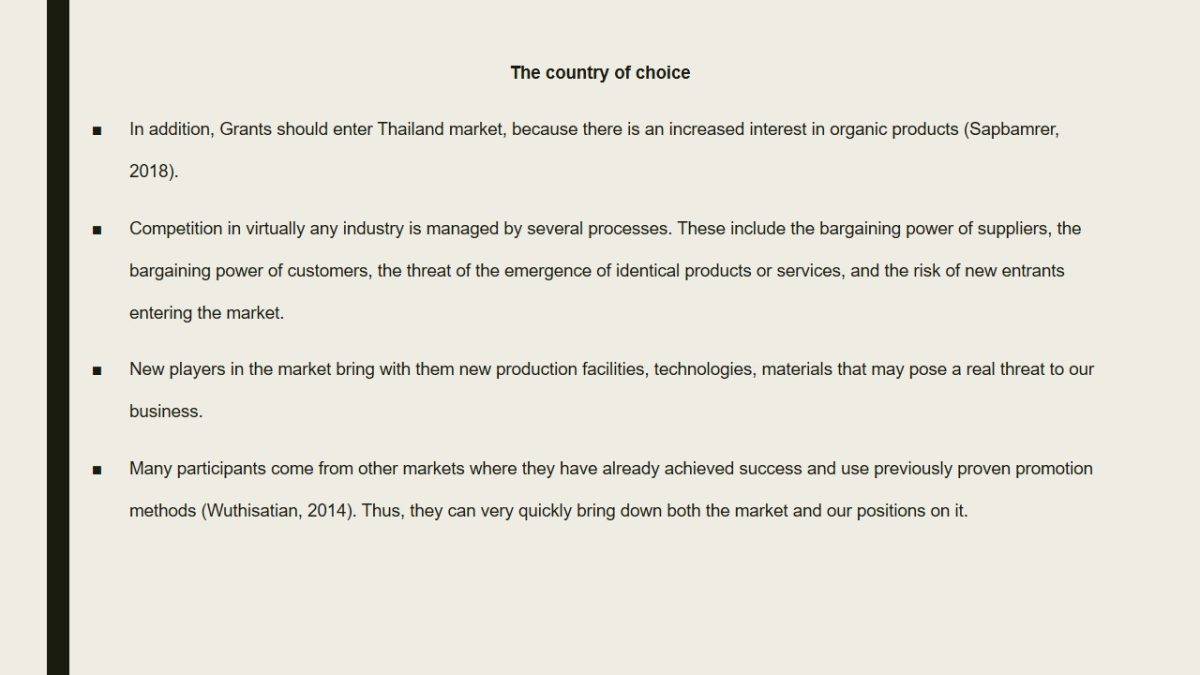
Thailand Market Analysis
The in-detail analysis results showed that the arsenal of oral hygiene products of therapeutic and prophylactic action is increasing every year. In addition, Thailand’s population is interested in natural and organic products, which the company Grants can target.
Although both Vietnam and Malaysia are good prospects for the market entry, the consumer market for organic products is not fully developed due to the political and religious nature of society. It should be noted that modern oral hygiene products are significantly different from their predecessors in composition and variety of forms of use (Redmond, 2018).
In Thailand, a lot of companies are engaged in the development of oral hygiene products. However, the main volume of products supplied to the market is provided by several large companies, including well-known global manufacturers: Colgate Palmolive, Procter & Gamble, Glaxo Smith Kline, and Dr. Theis (Phonthanukitithaworn, Ketkaew, & Naruetharadhol, 2019). All of this indicates that oral hygiene is quite enough to meet the needs of the Thai population.
However, the organic market is empty for a certain degree, which gives an outstanding opportunity and competitive advantage for Grants to enter the Thai market.
The market for organic products is expanding, which will increase chances for prosperous business operation. Among the manufacturers of hygiene products, there is a completely normal competition, pushing to improve their products further. The latter is carried out on the basis of long-term studies based on the latest scientific advances in preventive dentistry.
Nevertheless, today, there is the smallest flow of oral hygiene products from domestic manufacturers (Perkovic & Orquin, 2018).
Thus, oral hygiene is enough to fully provide preventive programs and meet the needs of adults and children in the dental markets. It is only necessary to make the right choice, taking into account the condition of the teeth and other objects of the oral cavity.
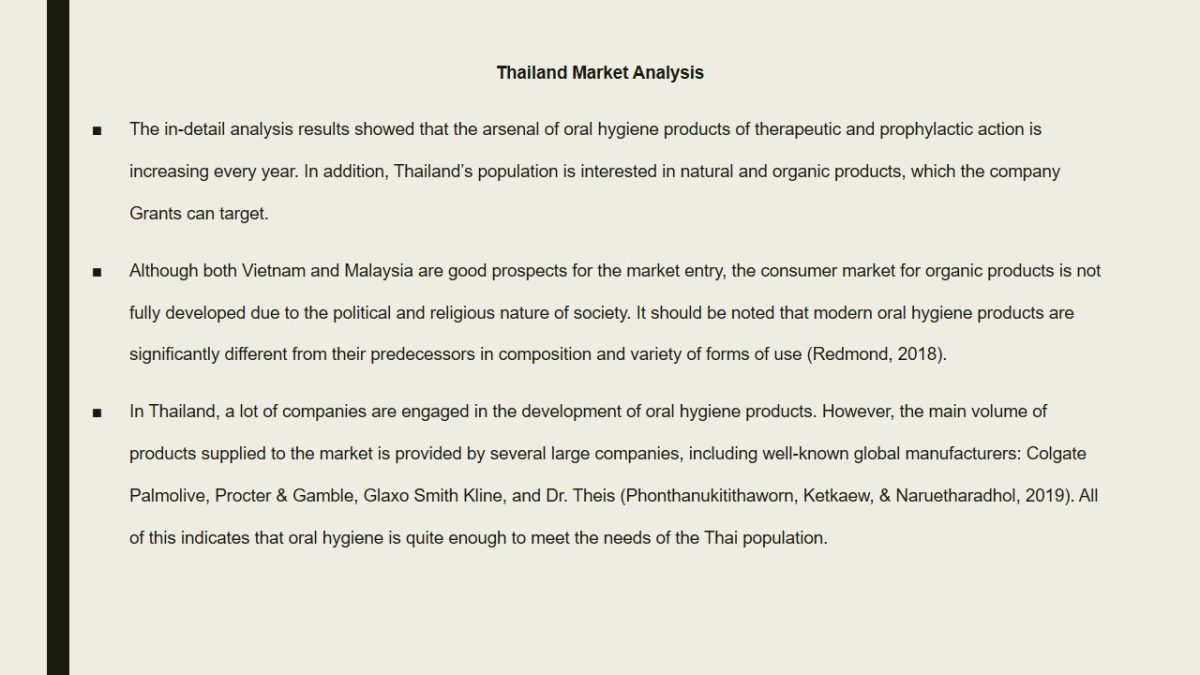
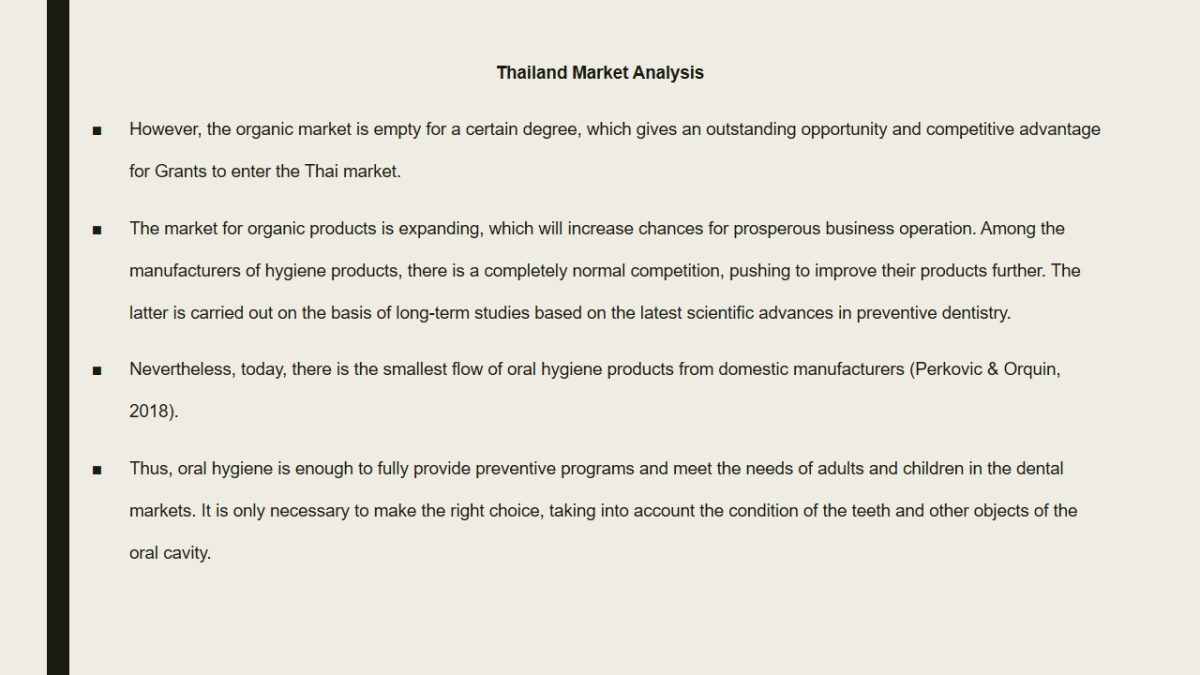
Market Entry Factors
There are factors that influence the effectiveness and size of the market entry barrier.
- Saving on a production scale. In industries where the volume of output has a direct impact on its cost, the appearance of new players is restrained, such an order forces them to enter the market with initially large volumes of production, or come to terms with significant costs, that is, with low profitability. This factor can serve as a significant barrier to entering the market in the sphere of distribution, finance, employment of sales personnel, and many other industries.
- Product differentiation. Brand awareness in the market is also an obstacle for new entrants. After all, for successful work, Grants will have to spend significant resources in order to earn consumer loyalty to their brand. The appearance of this factor is most likely in the sectors of production of medicines, cosmetics, as well as homemade toothpaste products.
- High fixed costs. Successful players may have the advantage of access to resources, which is closed to Grants regardless of their scale or scale of their production. These advantages can be expressed in advanced technologies, advantageous location, access to the best sources of raw materials, assets acquired at pre-inflationary prices (Day & Schoemaker, 2016). In some situations, benefits are protected by patents.
- Access to sales channels. New entrants must protect their distribution channels, and this can occur by forcing out existing goods from the shelves, by well-thought-out promotion policies, and flexible pricing policies. However, if there is more competition in the market, the more difficult it is for a new player to penetrate the industry and take a decent position there. In some cases, the company is forced to create its distribution channels, thus building its unique marketing system.
- The need for capital. The more funds are needed to enter the industry, the fewer will be willing to do so. Especially if the initial costs do not promise even potential income. These costs include research and development, advertising costs. Capital is becoming vital not only for the acquisition of the means of production, but also for the creation of inventories, the covering of organizational costs (Baker, Storbacka, & Brodie, 2018). A large enterprise with significant financial resources can enter almost any industry, but it is rarely possible for a start-up enterprise.
- State policy. By its actions and legislative decisions, the state can limit or close completely access to sources of raw materials and materials. Examples of such influence are legal acts in the field of trade in alcoholic beverages and tobacco products. More indirectly, but no less seriously, the state sets standards for air pollution, water, soil, thereby limiting the activities of enterprises that affect nature in this direction (Samiee & Chirapanda, 2019). However, Grants toothpaste products are not at high risk of getting into legislative issues due to the organic nature of the product.
Thus, taking into account all the above barriers to the emergence of Grants in the Thai market, it can be concluded that it is advisable to protect and continuously monitor the market situation timely. It is done in order to maintain positions for the continuous development and successful operation of the company in a dynamic, constantly changing external environment.
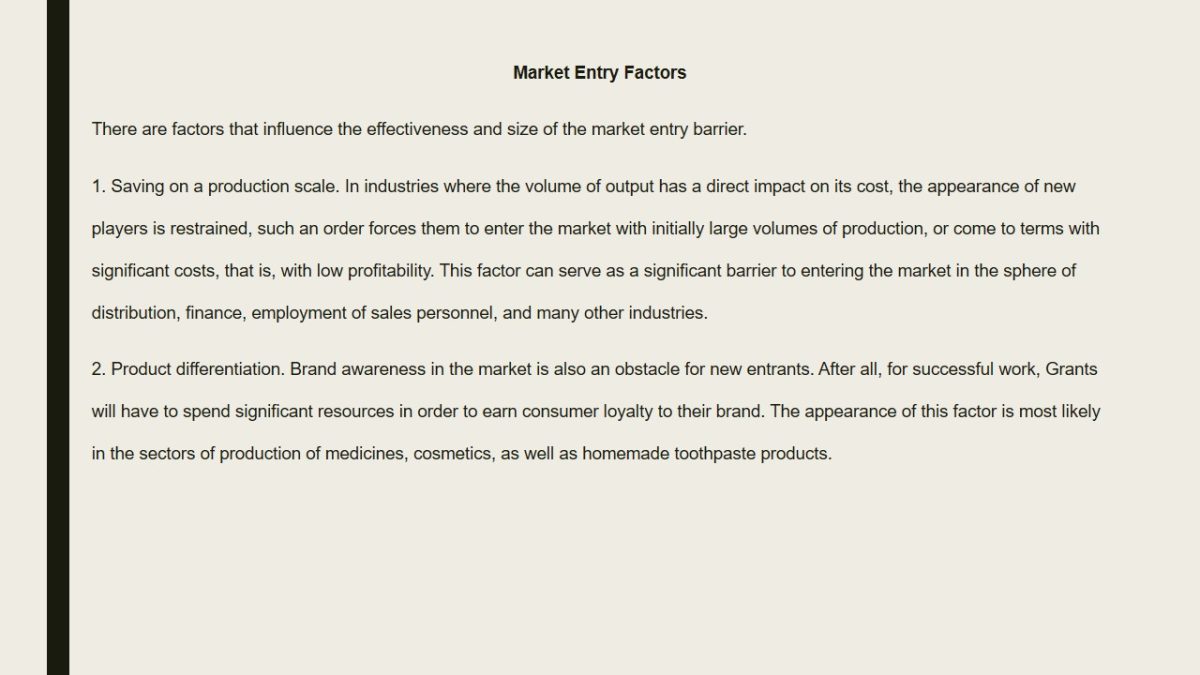
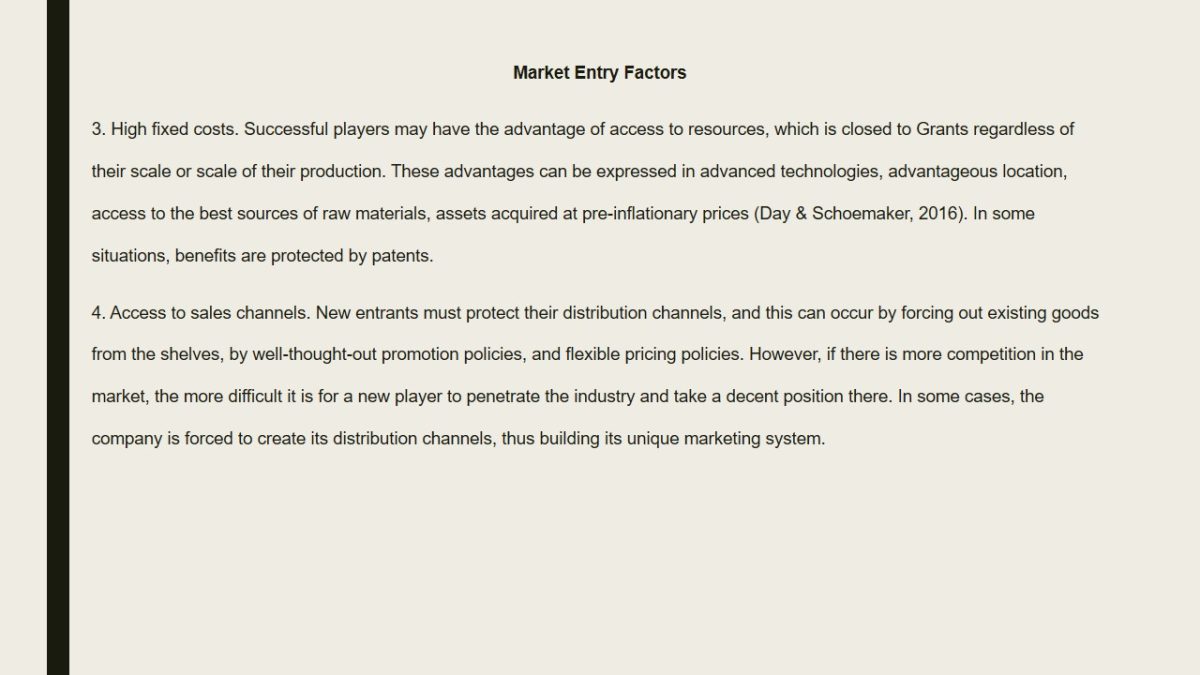
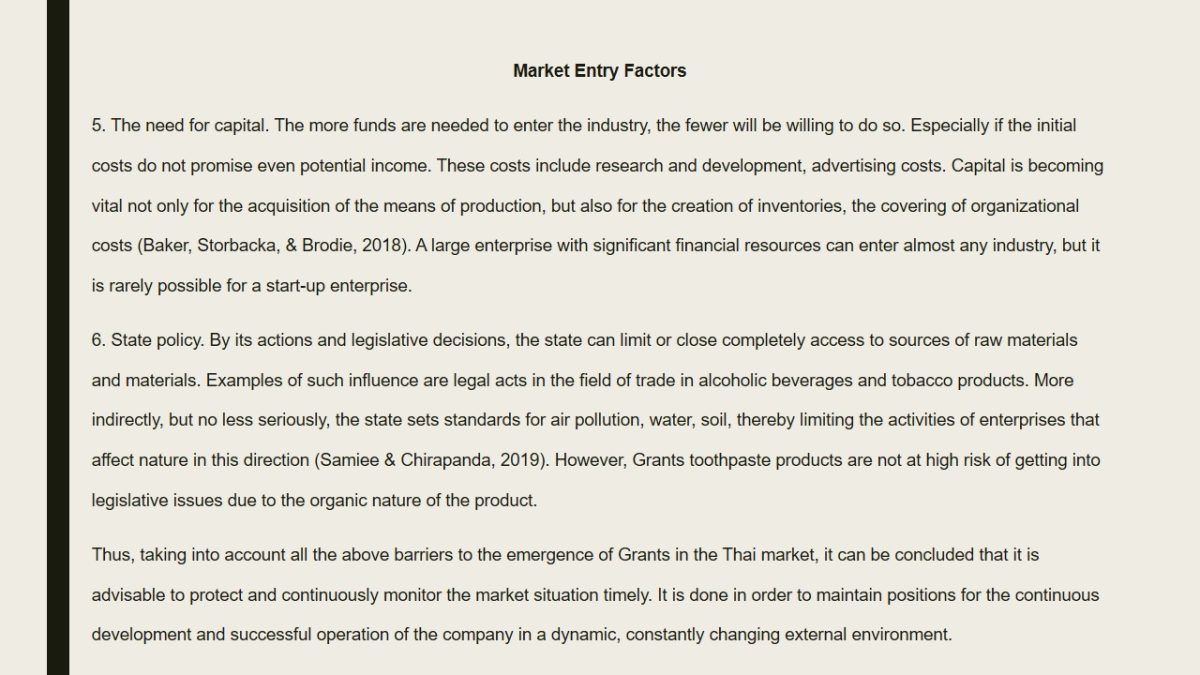
Major risks
- The major risks of creating and integrating an innovative product in a new market are the characteristic formation of consumers’ routine attitude towards traditional goods and services and the initial creation of new requirements for grocery innovations and innovations.
- In essence, this is the moment in time when consumers subconsciously want to switch to new products, but on the other hand, they are not yet ready to do this because of their psychological attachment to traditional products (Nenonen et al., 2014). In this case, the major risks will manifest itself in:
- Late response of producers and sellers to changes in consumer preferences (and as a consequence, the effect of lost profits);
- Complete or partial erroneous pre-production determination of consumer properties of an innovative product;
- Negative reaction of consumers to a sharp delay in the imposition of an innovative product;
- The probability of a definite change in consumer preferences in relation to innovation at the time of its technical and technological design.
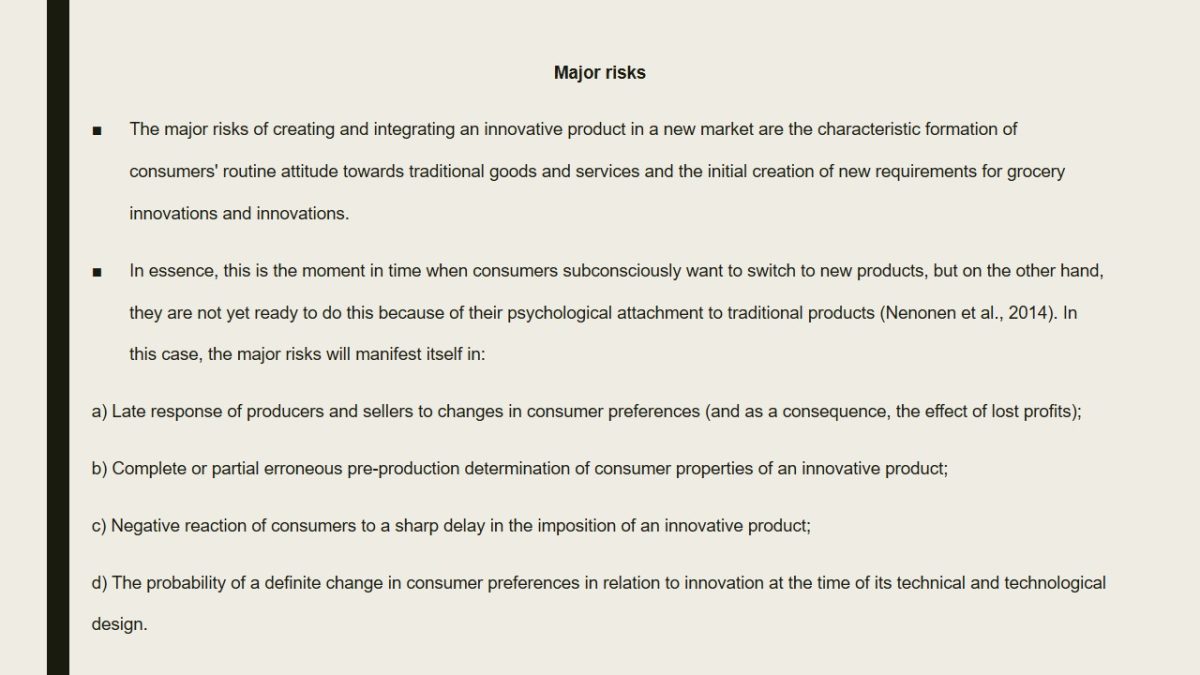
Mode of Entry and Reasons
The algorithm for introducing a marketing approach to motivation when promoting a product to the market is composed of several steps. They include segmentation of the external and internal public into groups of needs, which is thoroughly carried out. In addition, the company is ready to meet the needs and the target groups are identified .
Moreover, the needs of target groups are determined, and finally, a motivation system is created that can best meet the needs of each target group.
At the same time, everything happens under conditions of maximally informing clients and employees of the benefits of the reforms being carried out for them. The main reason is that the essence of the marketing model of motivation is that everyone needs to offer exactly what it lacks in this period of the lifecycle (Sangpikul, 2019).
Consumer incentives are fundamentally different from the schemes that are used in working with retailers and resellers. An effective system of motivation should be very flexible, and it should be reviewed frequently, as the nature and volume of work change over time.

The 5 steps of Implementation
- Market research and idea formulation:
- The product implementation process will involve an in-depth market analysis and research in order to identify the mode of entry, which determines the idea formulation procedure.
- Business plan:
- When an idea is formulated, the company directors need to understand whether it is financially viable (Nenonen et al., 2014). Thus, they need to create a business plan that necessarily includes the following information:
- Product Description;
- Market Situation and Competitors;
- Marketing Plan;
- Project Implementation.
- When an idea is formulated, the company directors need to understand whether it is financially viable (Nenonen et al., 2014). Thus, they need to create a business plan that necessarily includes the following information:
- Prototype creation and fundraising:
- It is important to consider the fact that product implementation can take several years. For example, Grants wants to introduce a new organic toothpaste or innovative brushing technology to the market that is created through experimentation and testing (Wang & Chen, 2018). As for financing, there is no need for large investments, because Grants can get by with the current capital.
- Development of the final product:
- After the market analysis is complete, the Grants can develop a new product or alter the currently existing one in order to adapt it to the new Thai population.
- Marketing and promotional activities:
- Strong marketing campaigns are needed, which will raise local awareness and promote organic products in general. The promotional activities should focus on Grants’ precise positioning, on being a leader in natural and healthy products.
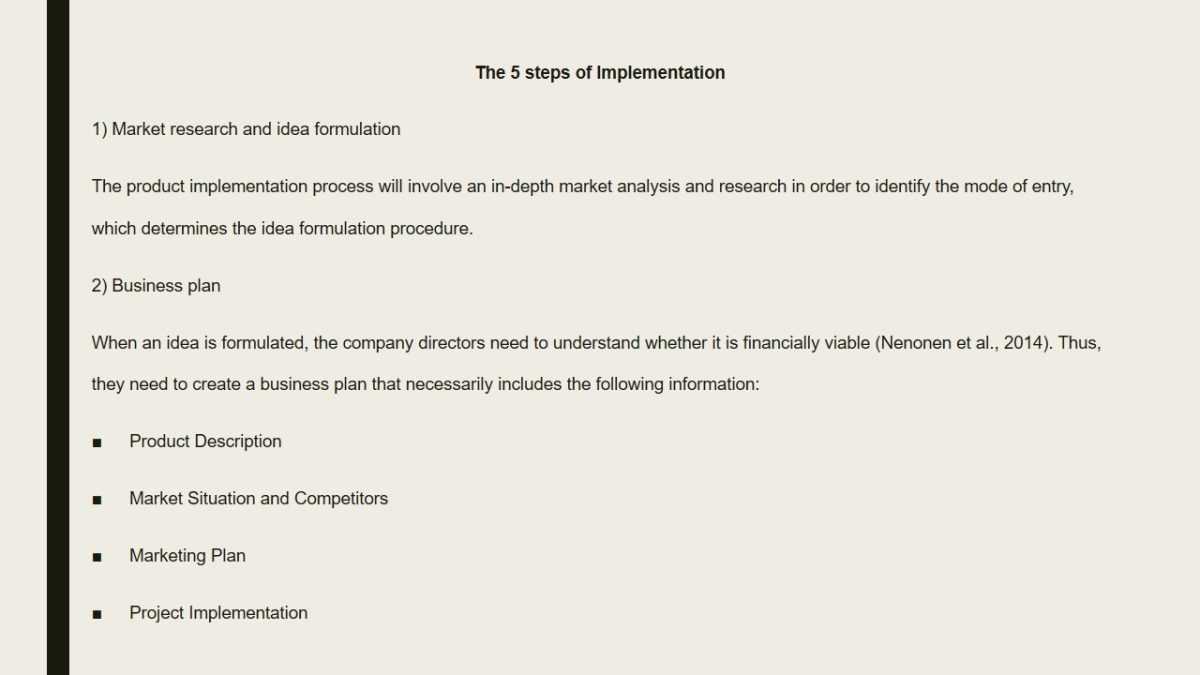
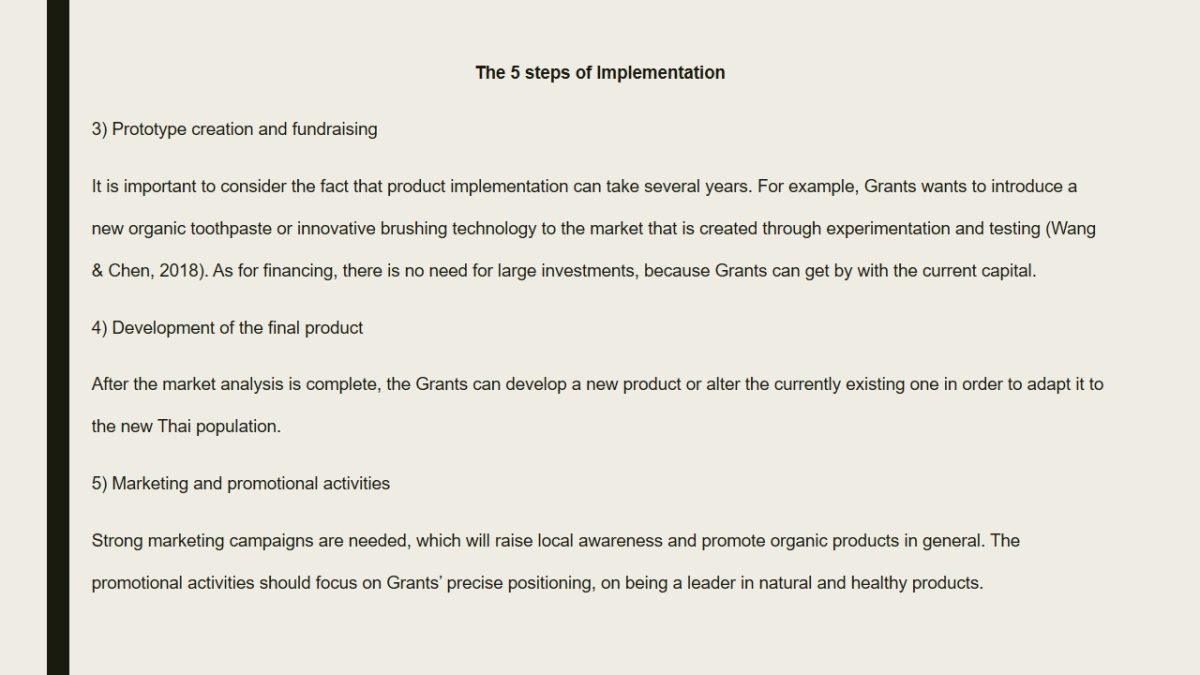
References
Baker, J. J., Storbacka, K. & Brodie, R. J. (2018). Markets changing, changing markets: Institutional work as market shaping. Marketing Theory, 1(1), 2-5.
Day, G. S. & Schoemaker, P. J. H. (2016). Adapting to fast-changing markets and technologies. California Management Review, 58(4), 59–77.
Nenonen, S., Kjellberg, H., Pels, J., Cheung, L., Lindeman, S., Mele, C., … Storbacka, K. (2014). A new perspective on market dynamics: Market plasticity and the stability–fluidity dialectics. Marketing Theory, 14(3), 269–289.
Perkovic, S. & Orquin, J. L. (2018). Implicit statistical learning in real-world environments leads to ecologically rational decision making. Psychological Science, 29(1), 34-44.
Phonthanukitithaworn, C., Ketkaew, C. & Naruetharadhol, P. (2019). Relevant factors for success as an online entrepreneur in Thailand. SAGE Open, 1(1), 1-3.
Redmond, W. (2018). Marketing systems and market failure: A macromarketing appraisal. Journal of Macromarketing, 38(4), 415–424.
Samiee, S. & Chirapanda, S. (2019). International marketing strategy in emerging-market exporting firms. Journal of International Marketing, 27(1), 20–37.
Sangpikul, A. (2019). Tourist perceptions of guided ecotourism tours in Thailand. Tourism and Hospitality Research, 1(1), 2-7.
Sapbamrer, R. (2018). Pesticide use, poisoning, and knowledge and unsafe occupational practices in Thailand. NEW SOLUTIONS: A Journal of Environmental and Occupational Health Policy, 28(2), 283–302.
Wang, T. & Chen, Y. (2018). Capability stretching in product innovation. Journal of Management, 44(2), 784–810.
Wuthisatian, R. (2014). Cointegration of stock markets: The case of Thailand. Review of Market Integration, 6(3), 297–320.